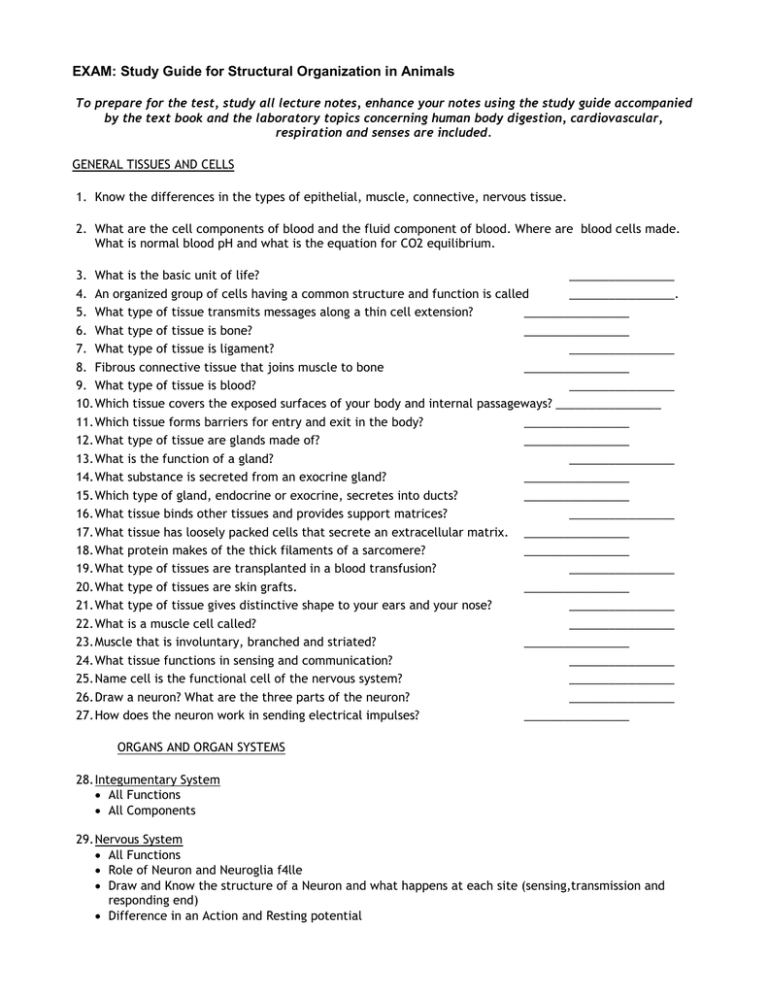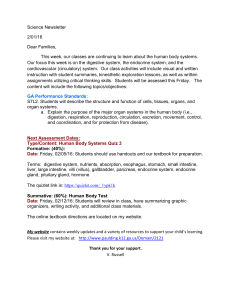Human Body Study Guide
advertisement

EXAM: Study Guide for Structural Organization in Animals To prepare for the test, study all lecture notes, enhance your notes using the study guide accompanied by the text book and the laboratory topics concerning human body digestion, cardiovascular, respiration and senses are included. GENERAL TISSUES AND CELLS 1. Know the differences in the types of epithelial, muscle, connective, nervous tissue. 2. What are the cell components of blood and the fluid component of blood. Where are blood cells made. What is normal blood pH and what is the equation for CO2 equilibrium. 3. What is the basic unit of life? ________________ 4. An organized group of cells having a common structure and function is called ________________. 5. What type of tissue transmits messages along a thin cell extension? ________________ 6. What type of tissue is bone? ________________ 7. What type of tissue is ligament? ________________ 8. Fibrous connective tissue that joins muscle to bone ________________ 9. What type of tissue is blood? ________________ 10. Which tissue covers the exposed surfaces of your body and internal passageways? ________________ 11. Which tissue forms barriers for entry and exit in the body? ________________ 12. What type of tissue are glands made of? ________________ 13. What is the function of a gland? ________________ 14. What substance is secreted from an exocrine gland? ________________ 15. Which type of gland, endocrine or exocrine, secretes into ducts? ________________ 16. What tissue binds other tissues and provides support matrices? ________________ 17. What tissue has loosely packed cells that secrete an extracellular matrix. ________________ 18. What protein makes of the thick filaments of a sarcomere? ________________ 19. What type of tissues are transplanted in a blood transfusion? ________________ 20. What type of tissues are skin grafts. ________________ 21. What type of tissue gives distinctive shape to your ears and your nose? ________________ 22. What is a muscle cell called? ________________ 23. Muscle that is involuntary, branched and striated? ________________ 24. What tissue functions in sensing and communication? ________________ 25. Name cell is the functional cell of the nervous system? ________________ 26. Draw a neuron? What are the three parts of the neuron? ________________ 27. How does the neuron work in sending electrical impulses? ________________ ORGANS AND ORGAN SYSTEMS 28. Integumentary System All Functions All Components 29. Nervous System All Functions Role of Neuron and Neuroglia f4lle Draw and Know the structure of a Neuron and what happens at each site (sensing,transmission and responding end) Difference in an Action and Resting potential Contrast PNS and CNS Contrast AUTONOMIC and SOMATIC Contrast Sympathetic vs. Parasympathetic The role of neurotransmitters: Dopamine, Seratonin, Epinephrine, Acetylcholine (AcH), GABA Receptors involved in hearing, equilibrium, seeing, touch, pain, blood pressure, blood pH. 30. Digestive System All Functions Role and identification of all organs (Mouth, esophagus, stomach, small intestine, small intestine rectum/anus). Enzymes from Mouth, Stomach, Pancreas and Small Intestine:Amylase, Pepsin, Trypsin, Sucrase,Protease, Nuclease and Lipase Role of Liver and Gall bladder and production of Bile and have it helps to breakdown fats Role of Stomach, Large and Small Intestine What Smooth Muscles Do 31. Circulatory System All Functions Identification and role of atria, ventricles, valves. Characteristics of Cardiac Muscles Components of Blood and Path of Blood Flow Contrast Veins, arteries and Capillaries What is Vena Cava and Aorta Electrical Circuit of the heart: Sino Atrial Node and the Valves Pulmonary Circuit and Systemic Circuit Structure of the Heart: Identify the 4 chambers and 4 valves in the Heart: Compare Rt vs Lt sides What is pulse and blood pressure, Diseases of the heart, (heart murmur, arteriosclerosis, high blood pressure and myocardial infarction) leukemia, congestive heart failure, ischemia, stroke, angina, anemia, 32. Immune systems All Functions All Components:L. Vessels, lymph, nodes, bone, cells and proteins Function of the following cells (Mast Cells, Phagocytes, Cytotoxic T, Helper T and Suppressor T, APC cells,B Cells) Proteins: Interferon, cytokines, compliment and porforin Non Specific and Inflammation Response: Vasodilation vs Vasoconstriction Specific Response (Antigens and Antibodies) Diseases: Autoimmune (lupus and rheumatoid arthritis), SCIDS, AIDS, CANCER, Leukemia 33. Respiratory System All Functions All Components (trachea, bronchus/oles, alveoli, 2 sets of muscles) Alveoli, how gas exchange occurs; compare atmospheric gases, alveolar gases, tissue and blood gases. Pressure in alveoli verses atmosphere. Muscles involved in breathing: Contrast inhalation with exhalation: Breathing Control Center in the brain Causes of Bronchitis, Tuberculosis, Pneumonia, Emphysema 34. Skeletal and Muscle Systems All Functions if Bone and Muscles (where and what is cartilage, ligaments and tendons) Human Biology: Fast vs slow twitch muscles Internal structure of Muscles and bones (draw each and label all parts) Effect of the hormones or neurotransmitters: HGH, parathyroid and calcitonin, Vit D and Ca. The components of a sarcomere and how a sarcomere makes a muscle contract How Ca influences Osteoblast and OsteoClast affecting Bone Density, Ossification Pituitary Dwarfism or Gigantism, Acondroplasia and Acromegaly, osteoporosis, osteoarthritis, arthritis 35. Endocrine System Definition of the Endocrine Gland; All Functions of the 9 glands; Negative verses Positive Feedback (which is Ca homeostasis, Sugar Metabolism, labor Hormones and their function from each of the 9 endocrine glands How ADH works to regulate blood pressure How Insulin and Glucagon Work = Negative Feedback for homeostasis of blood sugar How Oxytocin Works =Positive Feedback in labor The stress response and the Adrenal Gland, Stimulation of heart. How is epinephrine involved Calcitonin and PTH and homeostasis of blood calcium 36. Exocrine System All Functions of All Components (Kidney (nephrons), ureter, bladder, urethra) Renin/ Angiotensin/ Aldosterone System/ADH where each is produced and acts Draw The Nephron and know localized regional activity which includes Filtration, Reabsorption, Secretion and Excretion How Osmoregulation and Thermo regulation works How kidney is involved in blood pressure Factors that influence final urine volume. What is Dialysis, nephritis, Blood in urine, urine in blood, sugar in urine, protein in urine, diabetes mellitus vs insipitis. 37. Reproductive System All Functions and identity of all organs and structures. All Components: How FSH, LH, Testosteron, Estrogen and Progesterone affect reproduction Male Anatomy and Physiology, (What happens in testes,vas deferens, urethra, epidydimis, and 3 accessory gland) Anatomy of the sperm Role of 3 Hormone (FSH, LH and Testosterone )in male reproduction Female Anatomy and Physiology:what happens in ovary, fallopian tubes vagina, cervix and uterus Role of 4 Hormones ( FSH, LH, Est, Pro) in the monthly reproductive cycle (ovarian vs uterine cycle ) Hormones in Labor and Delivery What is a zygote, blastocoel, gastrula, embryo and fetus. Organ system derived from 3 germ layers (endoderm, mesoderm and ectoderm) AIDS, Gonorrhea, Syphillis, Clamydia, Herpes, HPV, Contraceptives: Pill, Diaphragm, Condoms, DISEASES 38. What effect does smoking have on the lung epithelial cells? ________________ 39. Under production of what hormone causes diabetes? ________________ 40. What diseases causes the body to attack itself? ________________ 41. A myocardial infarction is also known as ________________ 42. What organism cause an individual to develop an ulcer? ________________ 43. Hepatitis is a disease of what organ. ________________ 44. What organ system is attacked by HIV? ________________ 45. Rheumatoid arthritis is a disorder of which organ system? ________________ 46. What is a joint disorder? ________________ 47. What is the infectious agent of AIDS? ________________ 48. AIDS is a disease of which organ system? ________________ 49. What DISORDER promotes and inability in blood clotting? ________________ 50. What disorder is characterized by too few erythrocytes? ________________ 51. What is cancer of the white blood cells called? ________________




